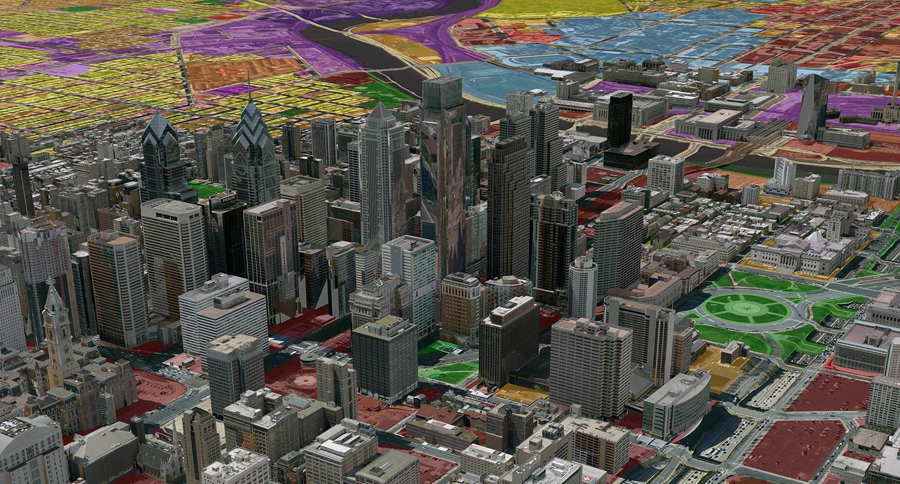
04 ก.ย. ภูมิศาสตร์ตัวแปรสำคัญสร้างโอกาสเติบโตให้ธุรกิจ
Posted at 09:53h
in Blog
“ธุรกิจและภูมิศาสตร์” ความสัมพันธ์ที่มากกว่าที่คิด
ในช่วงเริ่มต้นของอินเทอร์เน็ตในยุค 1990 มีการคาดการณ์เกี่ยวกับแนวคิด “The death of distance” และ “The end of geography” หลายคนทำนายว่าการเกิดขึ้นของเครื่องมือดิจิทัลอย่าง อีเมล และ อีคอมเมิร์ซ จะทำให้ “โลเคชัน” แทบไร้ความหมาย แต่ความจริงกลับตรงกันข้าม กว่าสามทศวรรษผ่านไปได้พิสูจน์ให้เห็นแล้ว “ธุรกิจและภูมิศาสตร์” ได้เชื่อมกันอย่างแนบแน่นอย่างไม่เคยเกิดขึ้นมาก่อน
ปัญญาประดิษฐ์ หรือ AI เป็นเทคโนโลยีที่ถูกพูดถึงมากที่สุดเพราะการทำงานเลียนแบบสมองมนุษย์และมีอัลกอริทึมที่ซับซ้อนเป็นอิสระเหนือกฎเกณฑ์ของโลกแห่งความจริง อย่างไรก็ตาม นวัตกรรม AI จำเป็นต้องใช้พลังงานไฟฟ้าจำนวนมหาศาลจาก Data center ที่มีสถานที่ตั้งตายตัว และมีการคาดการณ์ว่า AI จำเป็นต้องใช้พลังงานไฟฟ้ามากยิ่งขึ้นถึงหนึ่งในสามของความต้องการใช้ไฟฟ้าใหม่ทั้งหมดในสหรัฐอเมริกาในอีกสองปีข้างหน้า ปัญหาดังกล่าวทำให้บริษัท Amazon, Microsoft และ Google ต้องพยายามหาจุดสมดุลระหว่างการสร้าง Data center กับความเสี่ยงเฉพาะของพื้นที่ เช่น น้ำท่วมและคลื่นความร้อน รวมถึงต้องคำนึงถึงเป้าหมาย Net zero ขององค์กรอีกด้วย นี่เป็นเพียงหนึ่งในความท้าทายทางธุรกิจในปัจจุบันที่อาจแก้ไขไม่ได้ถ้าปราศจาก แผนที่ และ ข้อมูลเชิงพื้นที่ที่ได้จากเทคโนโลยีระบบสารสนเทศภูมิศาสตร์ (GIS)
“ภูมิศาสตร์และธุรกิจ” เพื่อกลยุทธ์และการดำเนินงาน
“แนวคิดทางภูมิศาสตร์” ช่วยให้นักบริหารประเมินตลาดและวิเคราะห์การดำเนินงานโดยพิจารณาจากปัจจัยต่าง ๆ ตั้งแต่ห่วงโซ่อุปทานทั่วโลก ผลกระทบต่อสิ่งแวดล้อม ความเสี่ยงด้านความปลอดภัย และข้อมูลอื่นๆ เช่น “Operational basemap” ช่วยให้บริษัทค้าไม้พัฒนาโครงการการป่าไม้ที่ยั่งยืนเพื่อรักษาป่าไม้ให้แข็งแรงในระยะยาว และทำให้เกิดกลยุทธ์การค้าปลีกแบบ Omnichannel ที่สร้างการเติบโตทั้งออนไลน์และในร้านค้า ส่วน “บริบททางภูมิศาสตร์” ก็สามารถช่วยให้ผู้นำธุรกิจตัดสินใจได้ดียิ่งขึ้น ทั้ง “Smart map” ก็ชี้ให้เห็นแนวโน้มของผู้บริโภคซึ่งส่งผลต่อการเลือกสถานที่ตั้งร้านค้าใหม่ หรือชี้ให้เห็นความเสี่ยงของโรงงานในภูมิภาคที่ขาดแคลนน้ำได้
แม้แนวโน้มธุรกิจอาจเปลี่ยนไป อุตสาหกรรมอาจผันผวน แต่ตราบใดที่มนุษย์ ธรรมชาติ และธุรกิจ ยังคงผูกพันกันบนพื้นที่ใดพื้นที่หนึ่งบนโลก “ภูมิศาสตร์” จะยังคงเป็นตัวแปรสำคัญที่ส่งผลต่อทุกการตัดสินใจ
ภูมิรัฐศาสตร์ นโยบายการคลังและการเงิน และกฎเกณฑ์ต่าง ๆ
ทราบหรือไม่ว่าสถานที่ตั้งของบริษัทนับว่ามีความเสี่ยงในด้านภาษีสรรพสามิต ภาษีอื่น ๆ และกฎเกณฑ์ทางการเงินต่าง ๆ เช่น ในเรื่องภาษีคาร์บอนนำเข้าของสหภาพยุโรป บริษัทสามารถนำ Operational basemap มาใช้เพื่อระบุห่วงโซ่อุปทานที่ได้รับผลกระทบ ซึ่งช่วยให้ผู้มีอำนาจตัดสินใจระบุสินทรัพย์ที่ใช้พลังงานไม่มีประสิทธิภาพ หรือระบุสถานที่ที่ควรติดตั้งระบบลดคาร์บอนเพื่อจำกัดค่าใช้จ่ายต่อไป
การประเมินความเสี่ยงดังกล่าวเกี่ยวข้องกับกรอบการตัดสินใจที่เรียกว่า “OODA Loop” อันประกอบด้วย การสังเกต (Observe) ปรับทิศทาง (Orient) ตัดสินใจ (Decide) และลงมือทำ (Act) ซึ่ง Jamie Dimon ผู้ดำรงตำแหน่ง CEO ของบริษัท JPMorgan Chase ได้กล่าวถึงในจดหมายถึงผู้ถือหุ้นเมื่อไม่นานมานี้ ไม่ว่าจะทำการตัดสินใจเกี่ยวกับการค้าโลกและนโยบายการคลังใด ๆ ขั้นตอนแรกที่สำคัญคือการประเมินความเสี่ยง ซึ่งการประเมินนั้นต้องเข้าใจสถานที่ตั้งด้วย เช่น หากธนาคารต้องการให้เงินทุนแก่บริษัทเกษตรกรรมแห่งหนึ่ง สามารถเทคโนโลยี GIS ทำการวิเคราะห์ภาพถ่ายดาวเทียม เพื่อประเมินว่าบริษัทนั้นทำเกษตรกรรมสอดคล้องกับกฎหมายความหลากหลายทางชีวภาพหรือไม่
ในโลกปัจจุบันที่ภูมิรัฐศาสตร์มีการเปลี่ยนแปลง ทั้งในเรื่องการค้าขายระหว่างประเทศ และกฎหมายเกี่ยวกับสภาพภูมิอากาศ เทคโนโลยี GIS ถือเป็นเครื่องมือที่จำเป็นอย่างยิ่งสำหรับผู้บริหารยุคใหม่ เพื่อใช้ติดตามการปรับเปลี่ยนนโยบายต่าง ๆ พร้อมปรับธุรกิจให้เท่าทันสถานการณ์ที่เปลี่ยนไป
การเติบโตทางธุรกิจ การวิเคราะห์ตลาด และการออกแบบห่วงโซ่อุปทาน
ธุรกิจที่มุ่งขยายกิจการมักพบความเสี่ยงจากการประเมินความสำคัญของภูมิศาสตร์ต่ำเกินไป มีตัวอย่างมากมายของร้านค้าปลีกในสหรัฐอเมริกาที่ไม่สบความสำเร็จในการขยายธุรกิจ เพราะมองข้ามรายละเอียดปลีกย่อยของทำเลที่ตั้ง
หนึ่งในนั้นคือ ร้านค้าปลีกชื่อดังของสหรัฐฯ ที่ขยายสาขามากกว่า 5,000 สาขาในช่วงกลางทศวรรษที่ผ่านมา จนกลายเป็นสถานที่คุ้นตาของคนในหลาย ๆ เมืองใหญ่ เยอะขนาดที่ CEO ของบริษัทฯ เคยนับร้านค้าได้ถึง 8 สาขาแค่ในระยะ 5 ไมล์จากบ้านของเขา แต่นั่นไม่ใช่ข้อดีนัก เพราะทำเลส่วนใหญ่มีร้านค้าตั้งใกล้กันเกินไป ทำให้เกิดการแย่งลูกค้ากันเอง
การประเมินความเสี่ยงอย่างถูกวิธีจะทำให้เห็นแนวโน้มทางภูมิศาสตร์และนำไปสู่ความสำเร็จของธุรกิจในที่สุด ตัวอย่างหนึ่งคือ ที่ปรึกษาผู้เชี่ยวชาญด้านโลเคชันของบริษัทที่ปรึกษาชั้นนำระดับโลกแห่งหนึ่งเลือกใช้แผนที่ GIS เพื่อวิเคราะห์ข้อมูลประชากรและการแบ่งเขต ทำให้สามารถแนะนำบริษัทอีคอมเมิร์ซได้ว่าควรเปิดร้านค้าใหม่ในย่านการค้าใดที่น่าสนใจที่สุด และถนนใดที่ดีที่สุด
เทคโนโลยี GIS ถูกนำมาใช้มากขึ้นเพื่อช่วยร้านค้าชั้นนำทำการวิเคราะห์ทางภูมิศาสตร์และประชากรศาสตร์ เพื่อเลือกทำเลที่ตั้งสาขา และออกแบบห่วงโซ่อุปทานให้มีประสิทธิภาพยิ่งขึ้น
ยิ่งไปกว่านั้น ความต้องการนักวิเคราะห์ที่เข้าใจภูมิศาสตร์ของโลจิสติกส์และเส้นทางการขนส่งก็เพิ่มสูงขึ้นอย่างมากด้วยเช่นกัน จนบริษัทต่างๆ ได้ทำความร่วมมือกับมหาวิทยาลัยเพื่อแข่งขันคัดคนที่ใช้เครื่องมือ GIS เก่ง ๆ เข้าร่วมงาน
โลกเปลี่ยนไป เราจะรับมือและลดผลกระทบได้อย่างไร
รายงาน Global Risks Report ประจำปีของ The World Economic Forum เผยถึงความเสี่ยงระยะยาว 4 อันดับแรกที่ระบุโดยผู้เชี่ยวชาญภาคธุรกิจ ภาคการศึกษา และภาคอื่นๆ ซึ่งล้วนเกี่ยวกับสิ่งแวดล้อมทั้งสิ้น ไม่ว่าจะเป็นสภาพอากาศสุดขั้ว การสูญเสียความหลากหลายทางชีวภาพ และการพังทลายของระบบนิเวศ ทั้งความเสี่ยงเหล่านี้ได้ส่งผลกระทบแตกต่างกันไปในแต่ละพื้นที่
ในการแก้ปัญหาดังกล่าวจำเป็นต้องทำ 2 อย่างควบคู่กัน คือ การลดผลกระทบ และการเตรียมพร้อมรับมือ ซึ่งหัวใจสำคัญของการแก้ปัญหานี้คือ การพิจารณาปัจจัยต่าง ๆ ผ่านมุมมองทางภูมิศาสตร์ ทั้งปัจจัยที่ควบคุมได้ เช่น การลดการปล่อยก๊าซคาร์บอน และปัจจัยที่ควบคุมไม่ได้ เช่น การเพิ่มขึ้นของระดับน้ำทะเล และผลกระทบจากน้ำท่วมที่คาดการณ์ไว้
บางบริษัทใช้เทคโนโลยีด้านโลเคชันเพื่อสร้างความพร้อมในการรับมือ โดยประเมินความเสี่ยงของสภาพอากาศที่อาจกระทบในบางพื้นที่ ในขณะที่อีกหลายบริษัททำการลดการปล่อยก๊าซคาร์บอนของตน โดยประเมินการทำงานของพื้นที่นั้น ๆ เช่น ร้านค้าปลีกสัญชาติสวิสแห่งหนึ่งใช้เทคโนโลยี GIS สร้างแผนที่แสดงความเร็วและความชันของถนน เพื่อวางกลยุทธ์การกระจายสินค้าที่ใช้พลังงานมีประสิทธิภาพที่สุด เป็นต้น
เข้าถึงทรัพยากรธรรมชาติและทรัพยากรมนุษย์
ที่ตั้งของธุรกิจในพื้นที่ต่างกันย่อมส่งผลต่อการเข้าถึงทรัพยากรที่ต่างกัน ไม่ว่าจะเป็นทรัพยากรธรรมชาติ เช่น ไม้ แร่ และน้ำ และทรัพยากรมนุษย์ที่เชี่ยวชาญงานที่บริษัทต้องการ แต่ด้วยเทคโนโลยี GIS ทำให้บริษัทมีข้อมูลเชิงลึกในแบบเรียลไทม์มากเพียงพอที่จะช่วยในการตัดสินใจได้อย่างมีประสิทธิภาพ
เทคโนโลยี GIS ช่วยให้ผู้บริหารสามารถใช้ Smart map เพื่อค้นหาตำแหน่งของแหล่งแร่ที่อาจจะขุดได้ ป่าไม้ที่สามารถตัดได้ หรือพื้นที่ที่มีศักยภาพเป็นพื้นที่อนุรักษ์ นอกจากนั้น ยังสามารถระบุถนนที่เครื่องจักรหนักสามารถเข้าไปในพื้นที่ รวมถึงพื้นที่อนุรักษ์ใกล้เคียง ไปจนกระทั่งแหล่งแรงงานที่พร้อมทำงานได้
อีกหนึ่งปัญหาสำคัญในปัจจุบันคือการขาดแคลนน้ำ เมื่อก่อนหลายบริษัทคิดว่าน้ำเป็นทรัพยากรที่หาได้ง่าย แต่เดี๋ยวนี้น้ำกลายเป็นปัญหาสำคัญในการดำเนินธุรกิจอย่างยั่งยืน โดยเฉพาะบริษัทที่มีโรงงานที่ต้องใช้น้ำจำนวนมหาศาลทุกวันอย่างบริษัทผลิตชิป เพื่อการเติบโตในระยะยาวการเลือกตั้งโรงงานจึงควรหลีกเลี่ยงพื้นที่ที่ขาดแคลนน้ำ และการใช้ Smart map ย่อมช่วยให้บริษัทมองเห็นพื้นที่ทางภูมิศาสตร์ที่มีความเสี่ยงจากภัยแล้งน้อยที่สุดได้
นอกจากนั้น เทคโนโลยี GIS ยังช่วยในการวิเคราะห์ข้อมูลเกี่ยวกับกำลังคน เช่น ผู้บริหารฝ่าย HR สามารถสร้างแผนที่แสดงข้อมูลเงินเดือนในแต่ละพื้นที่ เพื่อวางแผนการจ้างงานให้เหมาะสมกับพื้นที่นั้น ๆ เป็นต้น
เชื่อมความสัมพันธ์ของชุมชนและลูกค้า
การทำธุรกิจโดยคำนึงถึงสามด้าน นั่นคือ กำไร สังคม และสิ่งแวดล้อม ได้รับความนิยมมากขึ้นเรื่อย ๆ ในอดีตธุรกิจต่างมุ่งเน้นสร้างกำไรให้ผู้ถือหุ้นเป็นหลัก แต่ปัจจุบันผู้บริหารเริ่มตระหนักถึงความสำคัญของความสัมพันธ์ระหว่างผลิตภัณฑ์และบริการ ลูกค้า และชุมชนมากขึ้น ซึ่งความเข้าใจเหล่านี้ล้วนเกี่ยวข้องกับภูมิศาสตร์ทั้งสิ้น
ภูมิศาสตร์ถือเป็นปัจจัยสำคัญเมื่อบริษัทเทคโนโลยียักษ์ใหญ่ระดับโลกแห่งหนึ่งต้องการสนับสนุนองค์กรไม่แสวงผลกำไรที่ช่วยเหลือชาวอเมริกันผิวดำเพื่อส่งเสริมความเท่าเทียม หัวหน้าโครงการจึงใช้เทคโนโลยีด้านโลเคชันวิเคราะห์ข้อมูลด้านที่อยู่อาศัย การศึกษา และความยากจน เพื่อระบุพื้นที่ที่มีความเหลื่อมล้ำทางเชื้อชาติอย่างชัดเจน จากนั้นจึงร่วมมือกับองค์กรไม่แสวงผลกำไรในพื้นที่ทำการมอบเงินทุนและเครื่องมือดิจิทัลต่าง ๆ และทำการติดตามตัวชี้วัดความเท่าเทียมในชุมชนเพื่อประเมินผลโครงการต่อไป
ปัจจุบัน เราได้เห็นความใส่ใจของบริษัทต่าง ๆ ในการช่วยเหลือผู้ประสบภัยพิบัติมากขึ้น เช่น ร้านค้าปลีกขนาดใหญ่ได้ใช้ Operational basemap ในการกระจายเครื่องมือและอุปกรณ์ช่วยเหลือต่าง ๆ ทั้งหน้ากากอนามัยและกระสอบทรายจากโกดังสินค้าไปยังชุมชนที่ต้องการ และช่วยหน่วยงานภาครัฐจัดตั้งจุดแจกจ่ายน้ำและอาหารในลานจอดรถของบริษัท เป็นต้น
Jerry Johnston กรรมการผู้จัดการของบริษัท Deloitte & Touche กล่าวว่า ข้อมูลเกี่ยวกับโลเคชันที่ใช้ในการวางแผนและดำเนินงานต่าง ๆ ของบริษัทมีปริมาณมากขึ้นเรื่อย ๆ ในขณะที่ต้นทุนกลับลดลง นั่นหมายความว่า ตราบใดที่บริษัทยังต้องการรู้ว่าสิ่งต่าง ๆ อยู่ที่ไหน ไม่ว่าจะเป็นลูกค้า คู่แข่ง ทรัพยากร ไปจนกระทั่งความเสี่ยง บริบททางภูมิศาสตร์จะมีความสำคัญและมีมูลค่าเพิ่มมากขึ้นเรื่อย ๆ ด้วยเช่นกัน
ค้นหาศักยภาพของเทคโนโลยี GIS กับการประยุกต์ใช้ในอุตสาหกรรมอื่นๆ เพิ่มเติม
